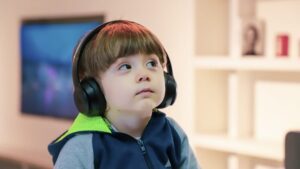Welcome to this informative article where we will delve into the world of Autism and Down Syndrome. These two conditions, although distinct, are often misunderstood and can be a source of confusion for many.
In this piece, we will analyze autism vs Down syndrome, their unique characteristics, challenges, and similarities between Autism and Down Syndrome, shedding light on these conditions in an emotional and empathetic tone.
For caregivers, here are some autism care tips you can adopt.
Autism vs Down Syndrome
Let us first describe two of them separately.
Understanding Autism
1. Definition and Prevalence
Autism, or Autism Spectrum Disorder (ASD), is a neurodevelopmental condition characterized by difficulties in social interaction, communication, and repetitive patterns of behavior. According to the latest statistics, autism affects approximately 1 in 54 children, making it a relatively common condition worldwide.
2. Key Features and Symptoms
Individuals with autism may exhibit a wide range of symptoms and behaviors, including challenges in socializing, difficulty with verbal and non-verbal communication, restricted interests, repetitive behaviors, and sensory sensitivities. It is important to note that autism is a spectrum disorder, meaning that the severity and manifestation of symptoms can vary significantly from person to person.
3. Challenges and Impact on Individuals
Living with autism can present various challenges for individuals. Difficulties in social interactions and communication can lead to feelings of isolation and frustration. Sensory sensitivities may result in discomfort or distress in certain environments.
However, it is crucial to understand that individuals with autism also possess unique strengths and abilities that should be recognized and nurtured. Find out more about autism’s early signs.
Understanding Down Syndrome
1. Definition and Prevalence
Down Syndrome, also known as Trisomy 21, is a genetic condition caused by the presence of an extra copy of chromosome 21. It occurs in approximately 1 in 700 births worldwide, making it one of the most common genetic disorders.
2. Physical and Intellectual Characteristics
Individuals with Down Syndrome often have distinct physical features, including upward-slanting eyes, a flat facial profile, and a single deep crease across the palm. They may also experience mild to moderate intellectual disabilities, delayed speech and language development, and various medical conditions such as heart defects and hearing loss.
3. Daily Challenges and Impact on Individuals
Living with Down Syndrome presents individuals with certain challenges. Cognitive delays and learning difficulties may require additional support in educational settings. Physical health issues, such as heart conditions, may necessitate ongoing medical care. However, with the right support and interventions, individuals with Down Syndrome can lead fulfilling lives and achieve personal milestones.
Differences Between Autism and Down Syndrome
1. Genetic Factors and Causes
Autism is believed to have a complex interplay of genetic and environmental factors, although the exact causes are still not fully understood. On the other hand, Down Syndrome is caused by a specific genetic anomaly, the presence of an extra chromosome 21.
2. Cognitive and Intellectual Functioning
While both Autism and Down Syndrome can involve intellectual disabilities, the nature of these disabilities differs. In Autism, cognitive abilities can range from below average to above average, with some individuals displaying exceptional talents in specific areas. Down Syndrome typically presents with a consistent pattern of intellectual disability, usually in the mild to moderate range.
3. Social Interaction and Communication
Impaired social interaction and communication skills are central features of Autism. Individuals with Autism may struggle with understanding social cues, maintaining eye contact, and engaging in reciprocal conversations. In contrast, individuals with Down Syndrome generally display more social responsiveness and may excel in establishing connections with others.
4. Sensory Sensitivities and Behaviors
Autism is often associated with sensory sensitivities, where individuals may be hypersensitive or hypersensitive to certain stimuli. This can result in discomfort or distress in response to noise, light, touch, or other sensory inputs. Down Syndrome, while not typically associated with sensory sensitivities, may involve certain behavioral patterns and repetitive movements.
Similarities Between Autism and Down Syndrome
1. Overlapping Challenges and Support Needs
Both Autism and Down Syndrome share common challenges related to socialization, communication, and cognitive development. Individuals with both conditions may require specialized educational programs, therapies, and support services to maximize their potential and enhance their quality of life.
2. Importance of Early Intervention and Therapies
Early intervention is critical for individuals with both Autism and Down Syndrome. Early diagnosis and access to appropriate therapies and interventions can greatly improve outcomes and help individuals develop essential skills, enhance communication abilities, and foster social connections.
3. Celebrating Individual Strengths and Abilities
While individuals with Autism and Down Syndrome face various challenges, it is important to recognize and celebrate their unique strengths and abilities. Many individuals with these conditions possess exceptional talents, creativity, and resilience. By providing a supportive and inclusive environment, we can help individuals with Autism and Down Syndrome thrive and contribute positively to society.
FAQs
1. Can a person have both Autism and Down Syndrome?
Yes, it is possible for an individual to have both Autism and Down Syndrome. In such cases, the challenges and support needs may be more complex and require a tailored approach.
2. Are there any known cures for Autism or Down Syndrome?
Currently, there is no known cure for Autism or Down Syndrome. However, early intervention, therapies, and support services can greatly improve the quality of life for individuals with these conditions.
3. Can individuals with Autism or Down Syndrome lead independent lives?
With appropriate support, individuals with Autism and Down Syndrome can lead fulfilling and relatively independent lives. The level of independence may vary depending on the individual’s strengths, abilities, and support systems in place.
4. How can I support someone with Autism or Down Syndrome?
Supporting individuals with Autism or Down Syndrome involves creating an inclusive and understanding environment. This can include promoting acceptance, providing access to appropriate therapies and interventions, and advocating for their rights and inclusion in society.
5. Where can I find more resources and support for Autism and Down Syndrome?
There are several organizations and support groups dedicated to Autism and Down Syndrome. These organizations provide valuable resources, information, and support for individuals and families affected by these conditions.
In Conclusion
Autism and Down Syndrome are two distinct conditions with their own set of characteristics, challenges, and impacts on individuals. Understanding the differences and similarities between these conditions is essential for promoting empathy, acceptance, and inclusivity. You can learn how to become a caregiver for these kids.
When we acknowledge the unique strengths and abilities of individuals with Autism and Down Syndrome, we can create a world that celebrates diversity and ensures equal opportunities for all.



